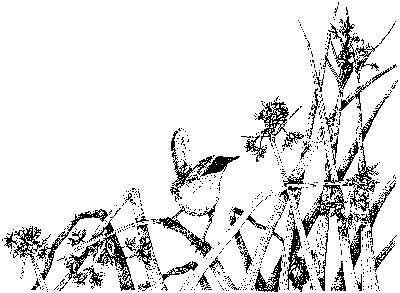


Living Lightly
By
LILLIAN VALLEE
24. From Bear Goddess to Grizzly Man
After the exhaustion of the first, very intense, week of classes, I found myself watching hundreds of sandhill cranes feeding in the corn stubble at the San Joaquin National Wildlife Refuge. And not quite all of them were feeding; some of the juveniles were busy tossing plant stalks into the air and then giving a little leap, in early preparation for the intricacies of courtship. It was surprising to see them in such numbers, surprising that they seemed so calm, so that if you stared too intently, they simply turned their backs and sauntered away politely, as if they were taking an evening stroll and had just decided to walk in another direction. Even under canopies of roiling Ross’s geese, punctuated by the flash and glide of a harrier, there is stillness at the refuge at dusk that conveys one into the past as surely as if one were traveling in a time machine.
The heavy rains had saturated the soil sloping away from the San Joaquin and had filled depressions with river water, creating, on a small scale, the wetlands that must have been such a common occurrence when the San Joaquin flooded in the beforetime.
How easily the imagination fills in the blanks: the herds of tule elk lost in the softness of juncus and bunchgrasses, the abrupt alertness of pronghorn, the vigilance of horned owls.
But what would the landscape evoke if suddenly, somewhere at its edges, the eye could detect the lumbering yet confident movements of a grizzly bear — a sow moving through the dense riparian brush, through a tunnel she had cleared to the river. There she looks for salmon moving upstream and when she spots one struggling, she holds it down and tears the eggs from the fish’s middle spilling some into the current. Flooding would not have constituted a problem for the California grizzly, a beautiful swimmer with water-shedding fur, nor would this bear have needed to hibernate in the Valley’s relatively mild winter climate, mitigated by wetlands full of food.
An account by J.B. Cocanour from December 1850 describes encounters with grizzlies on our Tuolumne River: “This ought to be called Bear River,” he writes to one Mr. Tigar, “there are so many grizzly bears around here. There is somebody killed here every week by them. There were three men attacked by one; one of them was killed, and another had his arm bitten off before they could kill it. I have seen a number of them, but have never been attacked. They always kept their distance, or rather I kept mine.”
Bears and people have been observing one another for a long time, and our language reflects this ancient relationship: women bear children. We can bear down on someone or bear up to unspecified misery. We eat bear claws (a pastry memory of a real delicacy), give bear hugs or lament a bear market. People with enthusiasm for a subject become bears as do those who are “gruff, burly, clumsy, or bad-mannered.”
Archeologists have found bear amulets (in Denmark, for example) that date back to the seventh millennium B.C. Maria Gimbutas, Lithuanian archaeologist, writes that, “the holiness of the bear, an animal of great strength and majesty, the glory of the forest, is universal in the northern hemisphere.” Dea Artio, or The Bear Goddess, venerated by the Celts, emerges from prehistory as one aspect of the Great Goddess, the pre-patriarchal creation of the Old European religious imagination. Clay figurines, found in the former Yugoslavia, Central Europe and Greece, date back to the fifth and sixth millennia B.C. and prefigure Marian figures with child. These “bear madonnas” or “bear nurses” are associated with motherhood, nurturing, and health (and are still fashioned of clay by native peoples in the American Southwest). The appearance of a bear in a village was considered good luck, and barren women and the sick sought out a bear’s healing powers. “Up to the twentieth century,” writes Gimbutas, “in the eastern Slavic lands, a newborn baby was laid by the grandmother on a bearskin” to ensure good health.
Today we have Yogi and Boo-Boo, Smokey and Paddington, or post office teddy bears with stamp facsimiles sewn to their chests. Humorless, forbidding Smokey; infantilized Yogi and Boo-Boo; or the very British (and heavily dressed) Paddington express a very different view of an animal that was once wild, beautiful and terrifying, linked directly to the experience of a great mystery, to dark sacrifice and healing. Of American writers, perhaps only William Faulkner in his (long) short story, “The Bear,” gets close to the fluid boundaries between people and bears, to the intricate protocols of their behavior, and to the power of the encounter.
And now a film by German filmmaker Werner Herzog invites us to reconsider some of these very old insights. Herzog edited the footage recorded by Timothy Treadwell, “amateur grizzly bear expert and wildlife preservationist, who lived unarmed among grizzlies for thirteen summers.” Treadwell, a recovering drug addict, also saw grizzly bears as healing and found his mission in protecting them, which he apparently did well because, according to his associates, not a single grizzly was poached on his watch. At the close of his fourteenth summer, he and his girlfriend were eaten by grizzlies in Alaska, something Treadwell clearly foresaw as a possibility when undertaking his work. The film moves from showing slightly sensationalized accounts of the death by an Alaskan coroner to renderings of Treadwell in various moods, from the ecstatic to the enraged. The film is haunting in what it cannot articulate.
Treadwell showed up at nature’s door wanting affection and healing, a purpose in life, and proof of a benevolent presence, much as people who seek UFO’s desperately want to know that they are not alone in the cosmos. What the bears thought about Timothy Treadwell we will never know, but they left him alone for thirteen summers. His death reminds us that sooner or later we become food, and that the search for salvation always teeters on the brink of self-annihilation.
Sources: Fort Wayne Sentinel, April 5, 1851, and Marija Gimbutas, The Language of the Goddess.
ACTION: The Modesto Junior College Civic Engagement Project Film Committee invites you to a viewing of the film Grizzly Man on March 23 in Forum 110 on the East Campus.

![]()
By ALLISON BOUCHER
Friends of the Tuolumne understands the frustration with the small salmon run in the Tuolumne River. It has declined significantly since the New Don Pedro Dam was built in the early 1970’s.
When a salmon hatchery was proposed, we were also interested in the hatchery as a tool to restore the historic numbers of Chinook salmon returning to the Tuolumne. We studied the database compiled by California Department Fish and Game (CDFG).
The database raised grievous concerns about hatchery fish competition with the naturally spawning fish, hatchery introduced diseases, and the serious risk of narrowing the diversity of genetics of our naturally spawning fish. The CDFG data clearly documented that hatcheries do not help sustain a fishery, but in fact hasten or cause the extinction of naturally spawning trout and salmon.
We raised these concerns with the US Fish and Wildlife Service and the California Department of Water Resources (the funding agency). Based on the science presented by the CDFG’s database, the hatchery was not funded.
Friends of the Tuolumne have worked hard during the last ten years to increase the flows in the Lower Tuolumne and restore spawning and rearing habitat for the Tuolumne River Chinook salmon. We have protected nearly 500 acres of riparian habitat and increased the instream spawning, holding, and rearing habitat in our project Bobcat Flat.
We have worked closely with CDFG to improve the salmon habitat near La Grange. As participants in the Tuolumne River Technical Advisory Committee, we have worked diligently to improve the river for the fish, and all our community members who value wildlife.
ACTION: If anyone has further questions or would like to be involved with our beautiful river, please call Friends of the Tuolumne at 209-477-9033.

![]()
A tentative settlement would award $500,000 to some 8,700 Westley area residents who claimed to have suffered health problems following the 34-day fire, which ignited a mountain of 5 million tires in western Stanislaus County in September and October of 1999.
The final personal injury suit brought against Modesto Energy Unlimited Partnership and related companies, owners and operators of the electrical co-generation tire-burning plant will allow an average payment of $30 to $45 per plaintiff after legal fees are paid. (See April 2000 special Tire Fire issue online here.
